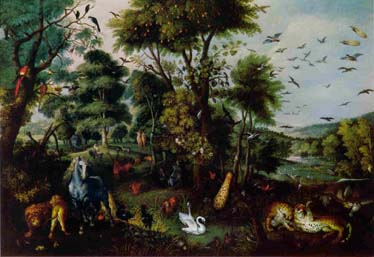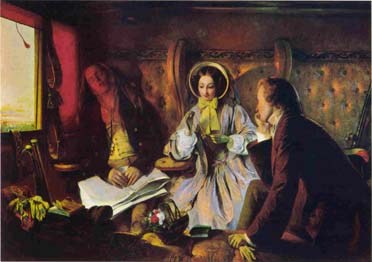
Bulletin 6 (III:2), 1965
Home
Français
Introduction
History
Annual Index
Author &
Subject
Credits
Contact


Recent Acquisitions
Nouvelles acquisitions
Pages 1 | 2
Marino Marini, born 1901 Italian
Horse and Rider
Marino Marini is a Tuscan sculptor. He was born at Pistoia and studied at the Academy in Florence. Until 1928 he was chiefly occupied with painting and graphic media. Since that date sculpture has made greater claims on his attention. In 1940 he was appointed professor of sculpture at the Brera Academy in Milan where he still teaches today. Filippo de Pisis, the painter, was among the first, as early as 1941, to praise Marini's Horsemen, a theme which has been constant in his sculpture. The variations to which he has subjected this theme are virtually countless, as it has been similarly developed in his painting and graphic work. The example acquired by the National Gallery is an early one clearly showing the derivation from archaic sculpture. It gains in importance, as it stands at the outset of the artist's remarkable metamorphosis of his theme: the rider is still tranquil, as if coming from afar, not yet revealing conflict, despair, defeat, torture, or ecstasy - all elements in the later groups.
Jean-Robert Ipoustéguy,
born 1920
French
Casque fendu
Jean-Robert Ipoustéguy was born at Dun-sur-Meuse, France.
It is only since 1954 that he has devoted all his time to sculpture, working
in clay, plaster, iron, wood and marble. At first occupied with the human
figure, powerfully and massively rendered, Ipoustéguy's most recent
work tends towards complete abstraction. Sound composition and vigorous appearance continue to
characterize his sculpture.
Roelandt Savery, 1576-1639
Flemish
Adam and Eve in Paradise
Roelandt Savery was the son of Jacob the Eider and received instruction
from his brother, Jacob the Younger. On visiting France during the reign
of Henry IV , he was employed at the royal palaces. After returning to the Low Countries, Savery was
invited by Rudolph II to the court of Prague. Here he spent a number of years painting landscapes
now in the Prague Museum. When the Emperor died in 1612 Savery settled
in Utrecht and lived there until his death. Though a famous painter during
his lifetime he is reputed to have died poor and insane. Savery is known
for his landscapes with animals, such as this one of Adam and Eve in
Paradise, and paintings of flowers. His style often resembles that
of Bril, Brueghel and other landscape painters of his day.
Abraham Solomon, 1824-1862
British
First Class: The Meeting. 1854
Abraham Solomon was the eider brother of
Simeon Solomon (1840-1905).
He was a student at the Royal Academy and from 1843 exhibited there and
at the British Institute. During the 1840s Abraham Solomon was preoccupied
with literary themes and painted scenes from Molière and Scott.
In 1854 he painted a pair of pictures, First Class: The Meeting and Second Class:
The Parting. It is the first of this pair which has now been acquired by the National Gallery. The great
delicacy of detail yet firm handling of medium, the care and reverence
displayed by the artist for his subject, make this an example of Victorian
painting at its most interesting.
Luis Feito, born 1929
Spanish
Red and Black Composition. 1964
This impressive painting in gouache by Luis Feito introduces the contemporary
Spanish school at the National Gallery. Born in Madrid, Feito studied there and
began exhibiting before settling in Paris. He has exhibited abroad frequently
and was represented several times at the Bjennials of São Paulo
and Venice. In
1959 a large one-man exhibition of his work was shown in the Spanish
pavillion in Venice.
Maurice Estève, born 1904
French
Composition
Maurice Estève's great interest in the paintings of Cézanne,
his intense admiration for primitive painting and for such artists as Fouquet
and Paolo Uccello, were important influences in his formative years. In
1956 the State Museum in Copenhagen honoured him with a retrospective exhibition
of works dating from 1929 to 1955. This exhibition traced Estève's
development from a post-cubist to an abstract style.
Tony Urquhart, born 1934
Canada
Landscape rondo
Tony Urquhart was born at Niagara Falls, Ontario. He studied at the Albright Art School, Buffalo, New York, under Seymour Drumlevitch and Larry Calcagno, and at the university of Buffalo. He was artist in residence at the University of Western Ontario, London, 1960-63. Urquhart is a highly sensitive landscape artist. His constant concern with phenomena in nature often reveals a mystical approach and sometimes surrealist overtones.
Next Page | Gordon Hammond
Smith
1 |
2
Annual Index | Author & Subject | Credits | Contact
This digital collection
was produced under contract to Canada's Digital Collections program,
Industry Canada.
"Digital
Collections Program, Copyright
© National Gallery of
Canada 2001"